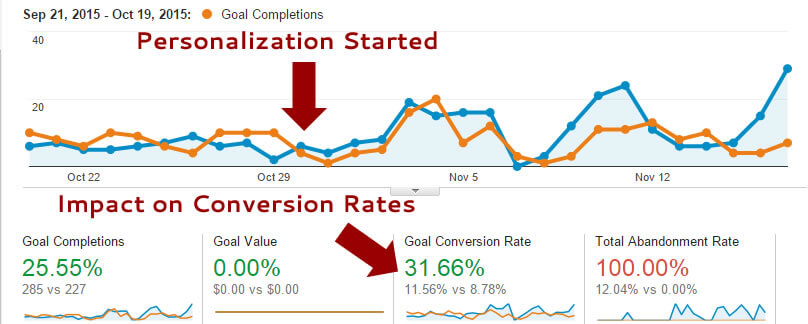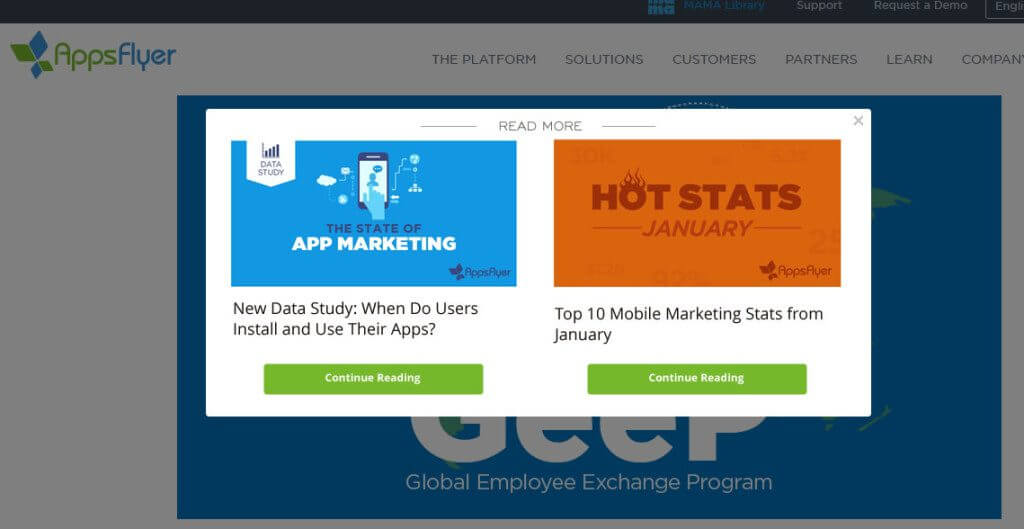How Content Personalization Can Amplify Your Marketing Automation

The purpose of this post is to explore the intersection between content personalization, marketing and automation. Before we can understand how personalization can help get better results from our marketing automation, let’s first discuss content and personalization.
Personalization – Identifying a person’s attributes and customizing the experience accordingly
The impact of personalization on performance cannot be understated. Here are some eye-opening stats to put things in perspective:
1) Marketers see an average increase of 20% in sales when using personalized web experiences. (source)
2) Personalized CTAs resulted in a 42% higher conversion rate than generic CTAs. (source)
3) Leads who are nurtured with personalized content produce a 20% increase in sales opportunities. (source)
4) 35% of Amazon’s revenue are generated by its recommendation engine. (source). For more stats on personalization, see here – link.

Why Personalization? A big impact on the bottom line, automatically
When we started TrenDemon, almost 3 years ago, the general assumptions about content and content marketing were that you need to create a lot of content and get it in front of your target audience as much as possible. Which article, what order, to what end, all that didn’t matter, just get them to read at least 7 articles, any 7, and you’re good. We started testing this theory and experimented with placing different articles in front of people at different stages of their journey. We quickly learned that by showing visitors the same articles but in a different order (we were using content recommendations to guide the visitors to the content we wanted to test), you can trigger significant differences in the results. Then, we experimented with showing different articles to different groups of people and also saw consistent changes in the result. At the end of the day, when you have a clear conversion goal in the site (like lead gen, signups, etc.), putting the right content, in the right time in front of the right person (content personalization), can help increase conversion rates by up to 4 times and achieve dramatic conversion optimization.
We also saw that different pages and posts can have a different impact on different goals. For example, some articles were good at getting visitors to subscribe to the newsletter while others were good at getting them to leave contact info to schedule a product demo.
Not all content is created equal – about Content Personalization
Content personalization is one aspect of personalization which deals with placing the right content in front of the right user at the right time. Especially in B2B marketing, content marketing plays a major role in the awareness, consideration and acquisition stages. B2B usually deals with complex products and offerings, sometimes technical and usually involves more that one decision maker in the organization. Content personalization can help streamline and optimize the customer journey (see here for more on personalizing and automating customer journeys through content) , bringing more knowledgeable prospects and leads, which later translates to more high value deals. Here is an example of TrenDemon’s Smart Recommendations on exit. In this example of content personalization the recommended articles are based on the relative position of the user in the journey (awareness, consideration, intent, retention). Also, these smart recommendations take into account content that the user has already read so not to bother the visitor with irrelevant content.

Marketing Automation and Personalization
Ok, so being able to show the relevant content to the specific user at the right time is important for improving conversion rates, but how does this relate to marketing automation? Well, we didn’t see the connection at first, but as we got more TrenDemon customers using different marketing automation platforms like Hubspot, Marketo, Pardot, Act-On, Silverpop and Autopilot, we started seeing the same underlying logic in all of them: all of those systems use a method of scoring and engaging leads based on their position in the journey, with the goal of driving as many relevant MQLs (marketing qualified leads) to become SQLs (sales qualified leads). They use personalized engagements (usually emails sent on some rule-basis) to help keep to get a user back in the funnel.
But before becoming leads, those people browsing the site were “just” visitors. If we could learn from the marketing automation or CRM platform the eventual true value of the contact or lead, we could trace it back and not only score the content, or score more effectively, but also the entire path. Cumulatively, we could then use those typical conversion paths to optimize future journeys. Another connection between content personalization and marketing automation happens further down the funnel – after conversion, sometimes even after a visitor becomes a customer. Then, the challenge is to retain, upsell and continuously engage the customer with relevant content and call to actions. For example, using TrenDemon’s integration to marketing automation platforms like Marketo, we can learn about the status of the visitor as they enter the site (whether new, lead, customer, partner, etc.) and show them appropriate content and call-to-actions based on their status. This helps maximize conversion rates and also, prevent from showing irrelevant messages and damaging the user experience.

Don’t just know what to show, also know what not to show
An often overlooked aspect of personalization is b
eing able to know when NOT to show something. For example, showing a visitor who is already subscribed to the blog, a pop-up message inviting them to sign up for the blog, is just bad experience. Not convinced? Just see this crazy stat: “88% of online consumers are less likely to return to a site after a bad experience.” (source).
Also, showing an article recommendation to a post the visitor has already read, just wastes valuable real-estate with content that could have been more relevant, especially when today getting the attention of a website visitor and engaging them is becoming increasingly difficult.
Understanding people, not pageviews
Effective personalization starts with correctly identifying the people who come to your site, what they are looking for and where you would like to lead them. This requires looking beyond number of visits, pageviews and other vanity metrics and deep into the way your customers engage your content. Only when you have a good understanding of how a typical customer journey interacts with your site and its content, can you move to the next level of engaging future, potential customers with personalized content and call to actions more effectively. Marketing automation platforms like Hubspot and Marketo are great at tracking and mapping the people behind the numbers. Combined with Trendemon’s Personalization units, this allows getting more visitors into the funnel, and the get them moving in it more efficiently.